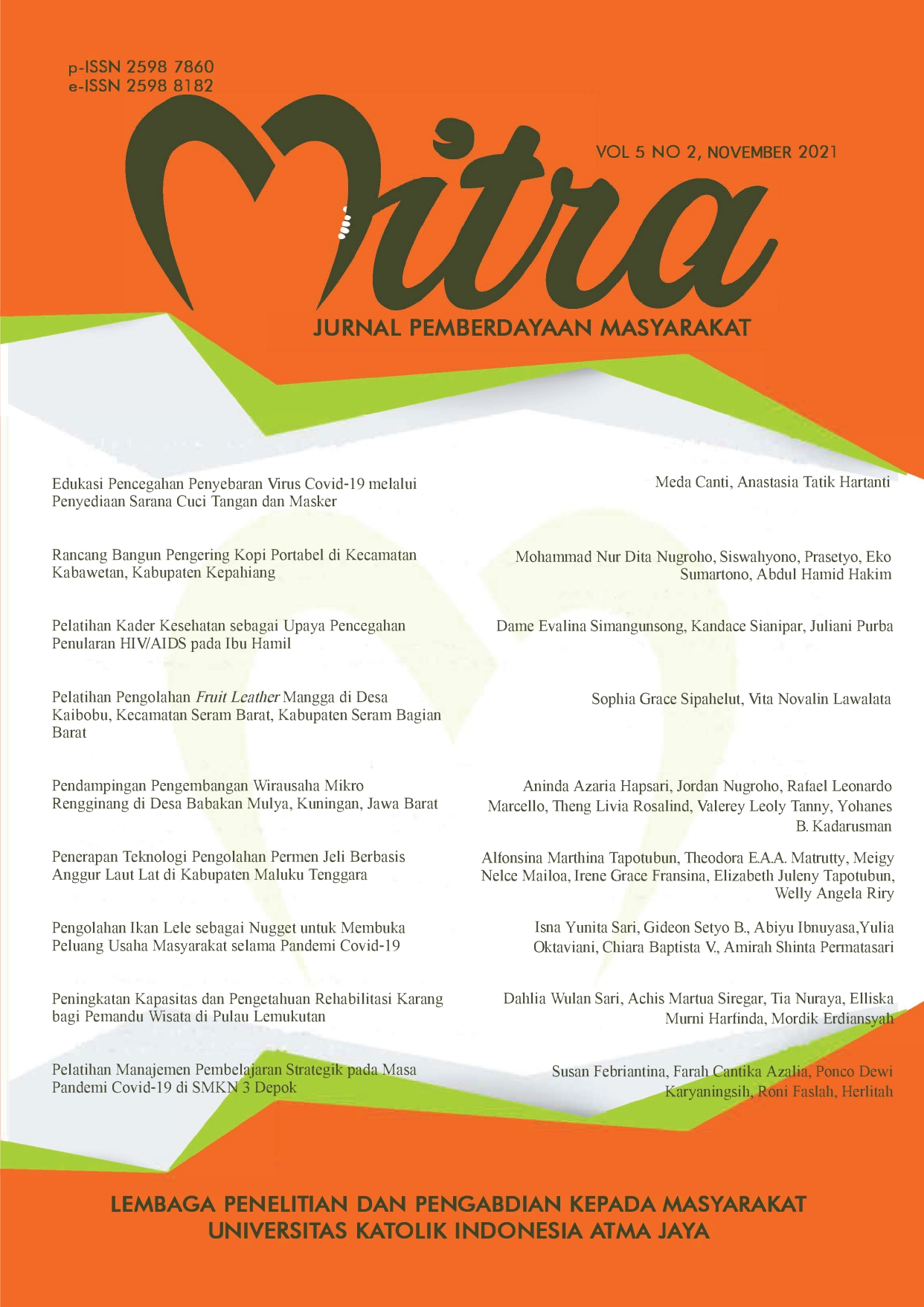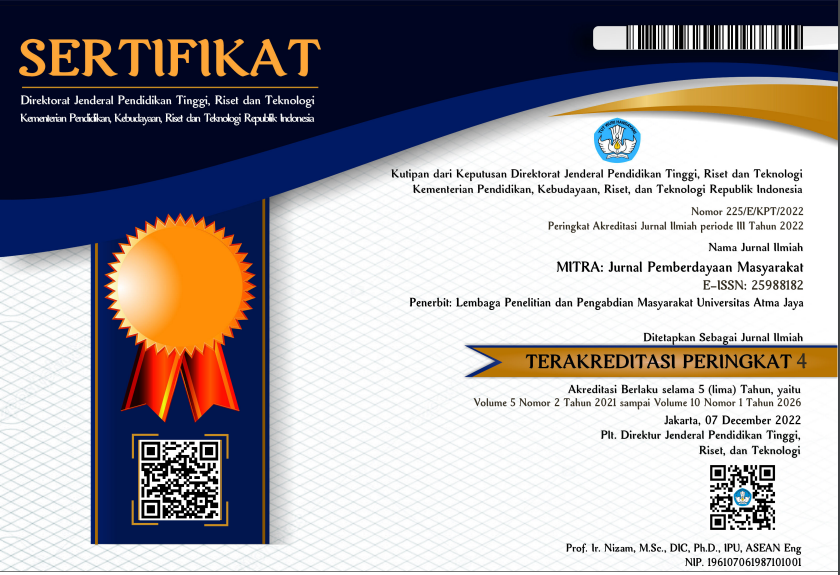Building the Capacity and Knowledge about Coral Rehabilitation of Tour Guides in Lemukutan Island
DOI:
https://doi.org/10.25170/mitra.v5i2.2853Keywords:
tour guide, alternative income, Lemukutan Island, coral reef, marine tourismAbstract
The coral reef ecosystem is one of the marine tourism attractions on Lemukutan Island, West Kalimantan. However, currently, some locations are in a relatively degraded condition, which should be addressed. One solution to this problem is coral transplantation activities involving tour guides. As part of the effort to rehabilitate the coral reef habitats, the Aquatic Resource Management Department, Faculty of Agriculture, Nahdlatul Ulama University, West Kalimantan, conducted community development activities to increase the capacity and knowledge of tour guides regarding coral reef ecosystems and coral transplantation techniques. This training was attended by fifteen tour guides from the Lemukutan Guide Group and ARTUNA (Anak Remaja Teluk Cina) Group. The participants were previously trained under PT Pertamina (Persero) and Yayasan Jejak Pesisir Nusantara. This training was carried out in three stages: (i) materials presentation and discussions, (ii) direct practice on the field, and (iii) evaluation. The post-test results showed that the training had increased participants' understanding of coral reef ecosystems and coral transplantation techniques by 40,00% and 33,33%, respectively.
References
Faisal, F., Lova, S. M., & Ananda, L. J. (2018). Potret efektivitas pelaksanaan corporate social responsibility (CSR) oleh PT Pertamina (Persero) Marketing Operation Region (Mor) I – Terminal Bahan Bakar Minyak (TBBM) Teluk Kabung melalui Program Bangun Industri Desa (Bid) Bisnis Perikanan di Kecamatan. Jurnal Pengabdian Kepada Masyarakat, 24(3), 770. https://doi.org/10.24114/jpkm.v24i3.11600.
Herison, A., & Romdania, Y. (2017). Bantuan penyuluhan dan kegiatan transplantasi terumbu karang di Pantai Ketapang Kabupaten Pesawaran. Sakai Sambayan Jurnal Pengabdian Kepada Masyarakat, 1(1), 23–28.
Iqbal, M., Indrajayanti, M., Syaifullah, S., & Hartati, H. (2020). Pemberdayaan masyarakat melalui transplantasi karang hias dengan media jaring di Taman Wisata Alam Laut (Twal) Pulau Satonda. Abdi Masyarakat, 2(2).
https://doi.org/10.36312/abdi.v2i2.1603.
Lachs, L., & Oñate-Casado, J. (2020). Fisheries and tourism: Social, economic, and ecological trade-offs in coral reef systems. YOUMARES 9- The Oceans: Our Research, Our Future, 243–260. https://doi.org/10.1007/978-3-030-20389-4_13.
Lasagna, R., Gnone, G., Taruffi, M., Morri, C., Bianchi, C. N., Parravicini, V., & Lavorano, S. (2014). A new synthetic index to evaluate reef coral condition. Ecological Indicators, 40, 1–9. https://doi.org/10.1016/J.ECOLIND.2013.12.020.
Muhlis, M. (2011). Ekosistem terumbu karang dan kondisi oseanografi perairan kawasan wisata bahari Lombok. Berkala Penelitian Hayati, 16(2), 111–118. https://doi.org/10.23869/bphjbr.16.2.20112.
Nurman, F. H., Sadarun, B., & Palupi, R. D. (2017). Tingkat kelangsungan hidup karang Acropora formosa hasil transplantasi di perairan Sawapudo Kecamatan Soropia. Sapa Laut, 2(4), 119–125. http://ojs.uho.ac.id/index.php/ JSL/article/view/3820/2911.
Okubo, N., & Onuma, A. (2015). An economic and ecological consideration of commercial coral transplantation to restore the marine ecosystem in Okinawa, Japan. Ecosystem Services, 11, 39–44. https://doi.org/https://doi.org/10.1016/j.ecoser.2014.07.009.
Pranata, N. B., Seto, A., & Sanova, S. (2018). Kondisi ekosistem terumbu karang di Teluk Cina Pulau Lemukutan Kalimantan Barat. Jurnal Laut Khatulistiwa, 1(2), 9-16.
Pratchett, M. S., Hoey, A. S., & Wilson, S. K. (2014). Reef degradation and the loss of critical ecosystem goods and services provided by coral reef fishes. Current Opinion in Environmental Sustainability, 7, 37–43.
https://doi.org/https://doi.org/10.1016/j.cosust.2013.11.022.
Pratiwi, D. B., Ramses, R., & Efendi, Y. (2019). Perbedaan laju pertumbuhan dan tingkat kelangsungan hidup karang jenis Montipora tuberculosa berasal dari induk transplantasi dengan induk dari alam. Simbiosa, 8(1), 10. https://doi.org/10.33373/simbio.
Roth, S. K., Powell, A., Smith, D. J., Roth, F., & Schierwater, B. (2018). The highly competitive ascidian Didemnum sp. threatens coral reef communities in the Wakatobi Marine National Park, Southeast Sulawesi, Indonesia. Regional Studies in Marine Science, 24, 48–54. https://doi.org/https://doi.org/10.1016/j.rsma.2018.07.001.
Runtuwene, S. M., Manembu, I. S., Mamangkey, N. G., Rumengan, A. P., Paransa, D., & Sambali, H. (2020). Laju pertumbuhan karang Acropora formosa yang ditranplantasi pada media tempel dan media gantung. Jurnal Pesisir dan Laut Tropis, 8(1), 98. https://doi.org/10.35800/jplt.8.1.2020.27553.
Subhan, B., Madduppa, H., Arafat, D., & Soedharma, D. (2015). Bisakah transplantasi karang perbaiki ekosistem terumbu karang? RISALAH KEBIJAKAN PERTANIAN DAN LINGKUNGAN: Rumusan Kajian Strategis Bidang Pertanian dan Lingkungan, 1(3), 159. https://doi.org/10.20957/jkebijakan.v1i3.10292.
Sudiono, G. (2008). Analisis pengelolaan terumbu karang pada kawasan konservasi laut daerah (KKLD) Pulau Randayan dan sekitarnya Kabupaten Bengkayang Provinsi Kalimantan Barat. 175.
Suharsono, Siringoringo, R. M., Hadi, T. A., Giyanto, Tuti, Y., Budiyanto, A., & Sulha, S. (2013). Perkembangan teknik transplantasi karang di Indonesia. Pusat Penelitian Oseanografi Lembaga Ilmu Pengetahuan Indonesia.
.
van Zanten, B. T., van Beukering, P. J. H., & Wagtendonk, A. J. (2014). Coastal protection by coral reefs: A framework for spatial assessment and economic valuation. Ocean & Coastal Management, 96, 94–103.
Webler, T., & Jakubowski, K. (2016). Mitigating damaging behaviors of snorkelers to coral reefs in Puerto Rico through a pre-trip media-based intervention. Biological Conservation, 197, 223–228. https://doi.org/10.1016/J.BIOCON.2016.03.012.
Zhao, M., Zhang, H., Zhong, Y., Jiang, D., Liu, G., Yan, H., Zhang, H., Guo, P., Li, C., Yang, H., Chen, T., & Wang, R. (2019). The status of coral reefs and its importance for coastal protection: A case study of Northeastern Hainan Island, South China Sea. Sustainability, 11(16), 4354. https://doi.org/https://doi.org/10.3390/su11164354.
Downloads
Published
How to Cite
Issue
Section
License
This license allows reusers to distribute, remix, adapt, and build upon the material in any medium or format for noncommercial purposes only, and only so long as attribution is given to the creator. If you remix, adapt, or build upon the material, you must license the modified material under identical terms.







_.jpeg)




.png)
2.png)
.png)
.png)



